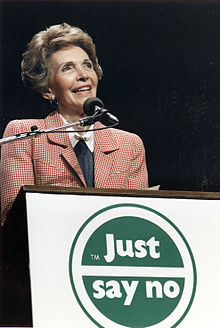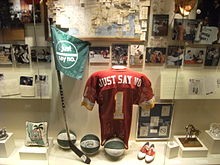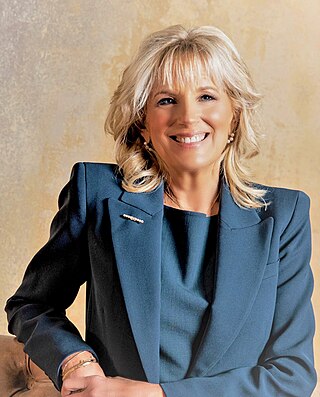
First Lady of the United States (FLOTUS) is the title held by the hostess of the White House, usually the wife of the president of the United States, concurrent with the president's term in office. Although the first lady's role has never been codified or officially defined, she figures prominently in the political and social life of the United States. Since the early 20th century, the first lady has been assisted by official staff, known as the Office of the First Lady and headquartered in the East Wing of the White House.

Nancy Davis Reagan was an American film actress and the First Lady of the United States from 1981 to 1989, as the second wife of president Ronald Reagan.

Barbara Bush was the first lady of the United States from 1989 to 1993, as the wife of George H. W. Bush, the 41st president of the United States. She was previously the second lady of the United States from 1981 to 1989, and founded the Barbara Bush Foundation for Family Literacy. Among her children are George W. Bush, the 43rd president of the United States, and Jeb Bush, the 43rd governor of Florida. She and Abigail Adams are the only two women to be the wife of one U.S. president and the mother of another. At the time she became first lady, she was the second oldest woman to hold the position, behind only Anna Harrison, who never lived in the capital. Bush was generally popular as first lady, recognized for her apolitical grandmotherly image.

Elizabeth Anne Ford was the first lady of the United States from 1974 to 1977, as the wife of President Gerald Ford. As first lady, she was active in social policy and set a precedent as a politically active presidential spouse. Ford also was the second lady of the United States from 1973 to 1974 when her husband was vice president.

Leah Sarah Betts was a young woman from Latchingdon, Essex, United Kingdom, who died shortly after her 18th birthday after taking an ecstasy (MDMA) tablet, and then drinking approximately 7 litres (1.8 US gal) of water in a 90-minute period. Four hours later, she collapsed into a coma, from which she did not recover. The inquest determined that the death had resulted from water intoxication and hyponatremia, which in turn led to serious swelling of the brain, though the ecstasy may have inhibited her ability to urinate.

Thelma Catherine "Pat" Nixon was the first lady of the United States from 1969 to 1974 as the wife of President Richard Nixon. She also served as the second lady of the United States from 1953 to 1961 when her husband was vice president.
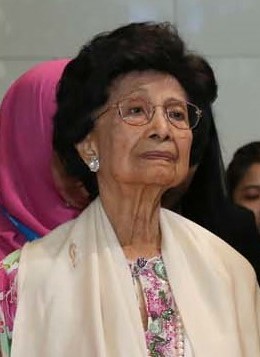
Tun Dr. Siti Hasmah binti Haji Mohamad Ali is the wife of Mahathir Mohamad, the 4th and 7th Prime Minister of Malaysia and former chancellor of the Multimedia University (MMU). She played the role of Spouse of the Prime Minister of Malaysia from July 1981 to October 2003 and from May 2018 to March 2020 for almost 24 years. She is the oldest-living person of the role.
Drug education is the planned provision of information, guidelines, resources, and skills relevant to living in a world where psychoactive substances are widely available and commonly used for a variety of both medical and non-medical purposes, some of which may lead to harms such as overdose, injury, infectious disease, or addiction.
The Nancy Reagan defense is a tactic in corporate finance used to counter a takeover or merger bidder who has made a formal bid to shareholders to buy their shares. When the board of directors of the target company meets to consider the bid, they "just say no."
"Stop the Madness" is an anti-drug music video uniquely endorsed and supported by United States President Ronald Reagan and the Reagan administration in 1985. The video includes Claudia Wells, New Edition, Toni Basil, La Toya Jackson, Whitney Houston, David Hasselhoff, Kareem Abdul-Jabbar, Kim Fields, Herb Alpert, Arnold Schwarzenegger, Darrell Creswell, Tim Feehan, Casey Kasem and Boogaloo Shrimp from the Breakin' franchise. Perhaps the main star of the video was Ronald Reagan's wife, Nancy Reagan, whose main cause as First Lady was speaking out against drugs, and forming the "Just Say No" anti-drug association. Mrs. Reagan appeared twice in Stop the Madness.
The Flintstone Kids' "Just Say No" Special is a 1988 animated television special featuring The Flintstone Kids and produced by Hanna-Barbera that aired on ABC on September 15, 1988. Nine days later, ABC aired the show again on ABC Weekend Special.

The Drug Free America Foundation (DFAF) is a 501(c)(3) nonprofit organization founded in 1976 by former US Ambassador Mel Sembler, his wife Betty Sembler (née Schlesinger), and Joseph Zappala as Straight, Inc., renamed The Straight Foundation, Inc. in 1985 and Drug Free America Foundation in 1995.

My Turn: The Memoirs of Nancy Reagan is an autobiography authored by former First Lady of the United States Nancy Reagan with William Novak. It was published by Random House in 1989.

Daytop, or Daytop Village, is a drug addiction treatment organization with facilities in New York City. It was founded in 1963 in Tottenville, Staten Island by Daniel Harold Casriel along with Monsignor William B. O'Brien, a Roman Catholic priest and founder and president of the World Federation of Therapeutic Communities. Ron Brancato from the Pelham Bay area of Bronx New York, Program Director and former resident of Synanon, California. Synanon was the only drug rehabilitation program until Daytop Village NY.

Ann Barbara Wrobleski was the architect of Nancy Reagan's "Just Say No" campaign and later United States Assistant Secretary of State for International Narcotics Matters from 1986 to 1989.

Diff'rent Strokes is an American television sitcom, which aired on NBC from November 3, 1978, to May 4, 1985, and on ABC from September 27, 1985, to March 7, 1986. The series stars Gary Coleman and Todd Bridges as Arnold and Willis Jackson, respectively, who are two boys from Harlem taken in by a wealthy Park Avenue businessman and his daughter. Phillip Drummond is a widower for whom their deceased mother previously worked; his daughter, Kimberly, is played by Dana Plato. During the first season and the first half of the second season, Charlotte Rae also starred, as Mrs. Edna Garrett, the Drummonds' first housekeeper, who ultimately spun off into her own sitcom, The Facts of Life, as a housemother at the fictional Eastland School. The second housekeeper, Adelaide Brubaker, was played by Nedra Volz. The third housekeeper, Pearl Gallagher, was played by Mary Jo Catlett, first appearing as a recurring character, later becoming a main cast member.
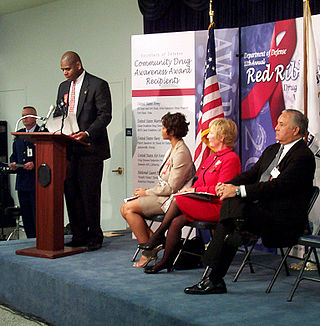
Partnership to End Addiction, formerly called The Partnership for a Drug Free America, is a non-profit organization aiming to prevent the misuse of illegal drugs. The organization is most widely known for its TV ad This Is Your Brain on Drugs.
The cannabis policy of the Reagan administration involved affirmation of the War on Drugs, government funded anti-cannabis media campaigns, expanded funding for law enforcement, involvement of the U.S. military in interdiction and eradication, reduction in emphasis in drug treatment, and creation of new Federal powers to test employees and seize cannabis-related assets.

Be Best is a public-awareness campaign promoted by First Lady Melania Trump, which focuses on well-being for youth and advocating against cyberbullying.

Begum Shafiq Zia was a Pakistani public figure who served as the First Lady of Pakistan from 1977 until her husband's death in a plane crash on 17 August 1988.
